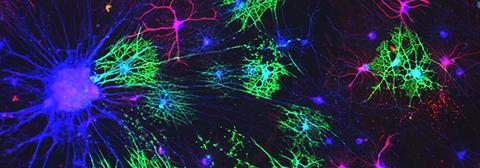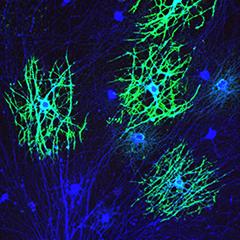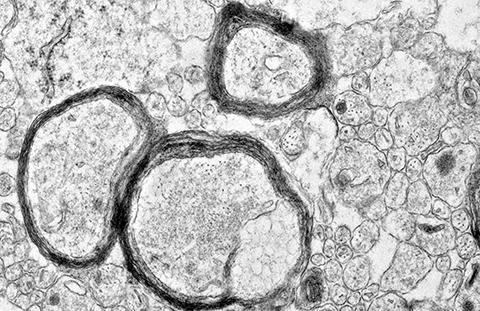The Sun Lab studies the most numerous cells in the brain, called “glial cells”. We aim to understand the fundamental principles that govern the communications between the nerve cells (neurons) and the glial cells in health and disease.
In vertebrates (including human beings), nearly half of the brain cells are non-neuronal cells. Most of them are glial cells, including astrocytes, oligodendrocytes, and microglia. Unlike neurons, glial cells do not fire action potentials but they are critical for normal nervous system function. We have focused on the oligodendrocytes, the sole myelin-producing cells in the central nervous system. Despite decades of research, how oligodendrocytes develop and communicate with neurons and other cell types remain mysterious. For example, why are oligodendrocytes always overproduced and then pruned? How do oligodendrocytes choose and ensheath nearby axons? Is there any selectivity between axons and individual oligodendrocyte’s processes (20-30 per oligodendrocyte)? How are the location and timing of myelination strictly controlled across diverse brain regions?
Our lab is dedicated to addressing these questions with multi-disciplinary approaches. To do that, we have combined mouse genetics, primary glial culture, biochemistry, electron microscopy, tissue clearance and super-resolution imaging, proteomics, and next-generation sequencing to identify and dissect out the underlying cellular and molecular mechanisms. Understanding how glial cells develop and communicate with others is essential to tackle many neurological diseases, including demyelinating diseases, brain tumors, and Alzheimer’s disease, that are significantly contributed by glial dysfunction.
We are actively seeking motivated postdoctoral fellows, graduate students, and undergraduate students to join our team.

Our Research
We are dedicated to understanding the mysterious stage during oligodendrocyte development. In order to become myelinating oligodendrocytes, oligodendrocyte precursor cells (OPCs) must stop proliferation and differentiate into an intermediate stage, called “pre-myelinating” oligodendrocytes. Pre-myelinating oligodendrocytes can only exist transiently (about 2-3 days in vitro and in vivo); they either become mature oligodendrocyte or undergo programmed cell death. Intriguingly, pre-myelinating oligodendrocytes start expressing large amounts of myelin RNAs and rapidly change their cellular machineries and morphologies. Our previous work has identified a critical intrinsic pathway governing pre-myelinating oligodendrocyte survival (Sun et al., Cell 2018), yet how do pre-myelinating oligodendrocytes sense and integrate nutrients, axonal contact, and intracellular stress cues remains unanswered.
We are using mouse genetics, genome-wide CRISPR/Cas screen, and live-cell imaging approach to address this question. In addition, we are taking advantage of pre-myelinating oligodendrocytes as a new model system to study cell death, stress responses, and autophagy to uncover new aspects of cell metabolism. Finally, we are developing genetic tools for targeting, labeling, and manipulation of pre-myelinating oligodendrocytes. Together this work will be valuable in studying oligodendrocyte development and further determining physiological function of pre-myelinating oligodendrocytes in developmental and myelin repair.

The communications between neurons and glial cells, as well as the ones among different glial cell types (astrocytes, oligodendrocytes, and microglia) are critical for normal nervous system function. The molecular and cellular mechanisms underlying these communications remain largely unknown. Oligodendrocyte-axon unit provides an excellent model to study neuron-glia interactions. Specifically, we are interested in the mechanisms that establish the initial axonal ensheathment by oligodendrocyte processes. Recent work showed that, intriguingly, the nervous system is inadequately myelinated; only a small portion of axons are myelinated even in the adulthood. In addition, there are also many unmyelinated segments along the myelinated axons. How do oligodendrocytes choose subsets of axons to myelinate? Is there any selectivity between axons and individual oligodendrocyte’s processes (20-30 per oligodendrocyte) that will myelinate these axons? What are the mechanisms governing the regional and temporal specificity across diverse brain regions? To address these questions, we have established primary oligodendrocyte-neuron co-culture platform as well as multiple in vivo murine systems, including the optic nerve (fully myelinated), the cortex (partially myelinated), and the cerebellum molecular layer (no myelination).

Gliosis was observed hundreds of years ago. It is tightly associated with many neurological diseases, including stroke, traumatic injury, multiple sclerosis (MS), Alzheimer’s Disease (AD), and Amyotrophic Lateral Sclerosis (ALS). In recent years, glial abnormality has been shown to occur before the onset of many neurological diseases, suggesting that glial cells may drive disease progression. Therefore, probing glial cells provides a unique angle in understanding and possibly treating these diseases. We are devoted to understanding the mechanisms underlying oligodendrocyte-associated diseases, including demyelinating diseases like neonatal white matter injury and multiple sclerosis. We have identified a few molecular handles and have established several animal models to address demyelination and remyelination mechanisms. In addition, we are interested in non-canonical oligodendrocyte diseases, including psychiatric disease and AD in which oligodendrocyte-specific genes are mysteriously dysregulated.
